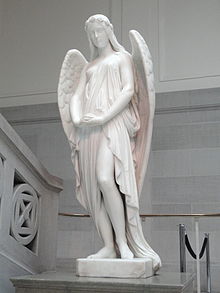Thomas Crawford (sculptor)
Thomas Gibson Crawford | |
|---|---|
 Thomas Crawford, 1846 | |
| Born | Thomas Gibson Crawford March 22, 1814 New York City, US |
| Died | October 10, 1857 (aged 43) London, UK |
| Burial place | Green-Wood Cemetery in Brooklyn, New York |
| Occupation | Sculptor |
| Spouse |
Louisa Cutler Ward
(m. 1844) |
| Children | 4, including Mary and Francis |
Thomas Gibson Crawford (March 22, 1814 – October 10, 1857) was an American sculptor who is best known for his numerous artistic contributions to the United States Capitol, including the Statue of Freedom atop its dome.
Early life
Crawford was born in New York City in 1814, of Irish parentage, the son of Aaron and Mary (
In 1834, he went abroad for the promotion of artistic studies, and in the summer of 1835 took up his residence in Rome, for life as it proved. Launitz had provided Crawford with a letter of introduction to
Career


His first ideal work was a group of Orpheus and Cerberus, executed in 1839, and purchased, some years later, for the


In 1849, while on a visit to this country, he received from the
U.S. Capitol
Crawford's most important works after these were ordered by the federal government for the
His major accomplishments include the figure above the dome of the
Personal life
In 1844, he married Louisa Cutler Ward, a daughter of Julia (née Cutler) Ward and banker
- Mary Crawford Fraser (1851–1922),[7] a writer who in 1874 married diplomat Hugh Fraser (1837–1894), who served as the United Kingdom's Ambassador to Japan from 1889 to 1894 during the reign of Queen Victoria and Emperor Meiji.[8]
- Francis Marion Crawford (1854–1909), a writer who married Elizabeth Berdan, the daughter of the Union General Hiram Berdan, in 1884.
In politics he was a liberal, in religion a Protestant, in character generous and kindly, and adverse to discords, professional or social.[4]
Crawford began experiencing significant deterioration in his vision in 1856, which ended his career. He sought medical treatment in Paris, Rome, and London, and physicians discovered cancer of the eye and cancer of the brain. He died in London on October 10, 1857. His body was returned to the United States, and buried in an unmarked grave at Green-Wood Cemetery in Brooklyn, New York.[9]
Works
- Mexican Girl Dying (1848)
- Statue of Freedom (1862)
- Progress of Civilization Pediment (1863)
- George Washington and the Revolutionary War Door (1868)
- Revolutionary War Door (1905)
References
- Notes
- ^ Gale 1964, p. 5.
- ISBN 0-87099-957-5.
- ^ "Thomas B. Crawford, American (1813 - 1857)". Ro Gallery.
- ^ a b c d Howe 1900.
- ^ "James Otis and Mercy Otis Warren".
- ^ "Samuel Ward Papers" (PDF). nypl.org. New York Public Library Archives. Retrieved 7 February 2017.
- ISBN 1-873410-90-5.
- ^ "FRASER, Mrs. Hugh". Who's Who. Vol. 59. 1907. p. 636.
- ^ Gale 2003, p. 51.
- Sources
- This article incorporates text from a publication now in the public domain: Chisholm, Hugh, ed. (1911). "Crawford, Thomas". Encyclopædia Britannica (11th ed.). Cambridge University Press.
- Gale, Robert L. (1964). Thomas Crawford: American Sculptor. Pittsburgh: University of Pittsburgh Press. ISBN 031332350X.
- Gale, Robert L. (2003). A Henry Wadsworth Longfellow Companion. Westport, Conn.: Greenwood Press. ISBN 031332350X.
- Howe, Julia Ward (1900). . In Wilson, J. G.; Fiske, J. (eds.). Appletons' Cyclopædia of American Biography. New York: D. Appleton.
External links
- [1], Marking an Artist's Forgotten Grave with His Own Sculpture of Death
- Art and the empire city: New York, 1825-1861, an exhibition catalog from The Metropolitan Museum of Art(fully available online as PDF), which contains material on Crawford (see index)
- Bust of Thomas Crawford at the New-York Historical Society by Giuseppe Blasetti.
